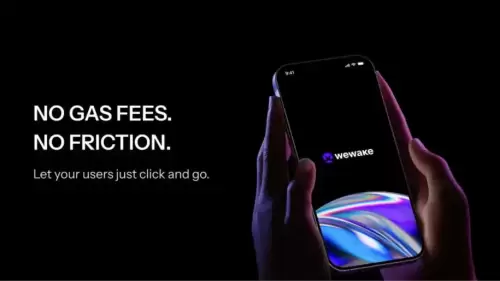 |
|
 |
|
 |
|
 |
|
 |
|
 |
|
 |
|
 |
|
 |
|
 |
|
 |
|
 |
|
 |
|
 |
|
 |
|
Cryptocurrency News Articles
Before You Buy Bitcoin, You'll Need a Crypto Wallet
May 27, 2025 at 11:31 pm
Before entering the crypto scene and buying your first Bitcoin (or other token), you’ll need a crypto wallet—a tool that lets you manage, send, receive, and interact with cryptocurrencies.

Before entering the crypto scene and buying your first Bitcoin (or other token), you’ll need a crypto wallet—a tool that lets you manage, send, receive, and interact with cryptocurrencies.
Before entering the crypto scene and buying your first Bitcoin (or other token), you’ll need a crypto wallet—a tool that lets you manage, send, receive, and interact with cryptocurrencies.
Choosing the right wallet is the first (and most important) step toward safely managing your digital assets. Here’s how to choose and set up the right crypto wallet, including hot vs. cold storage options and how to keep your wallet secure.
Choosing the right wallet is the first (and most important) step toward safely managing your digital assets. Here’s how to choose and set up the right crypto wallet, including hot vs. cold storage options and how to keep your wallet secure.
Key Takeaways
Understanding Crypto Wallets
Understanding Crypto Wallets
Despite the name, a cryptocurrency wallet doesn’t hold your digital coins directly. Instead, it stores the private and public keys (and seed phrases) that let you access and manage them on the blockchain. A crypto wallet also allows you to interact with blockchain networks in order to manage your cryptocurrency.
Despite the name, a cryptocurrency wallet doesn’t hold your digital coins directly. Instead, it stores the private and public keys (and seed phrases) that let you access and manage them on the blockchain. A crypto wallet also allows you to interact with blockchain networks in order to manage your cryptocurrency.
Your private key is like the key to your safety deposit box, and your public key is like your mailing address for receiving crypto. If someone gets your private key, they can access your funds. If you lose it, you may lose access to your cryptocurrency permanently.
Your private key is like the key to your safety deposit box, and your public key is like your mailing address for receiving crypto. If someone gets your private key, they can access your funds. If you lose it, you may lose access to your cryptocurrency permanently.
If someone knows your public key, they can send you cryptocurrency, and you can use your private key to decrypt the funds and add them to your balance.
If someone knows your public key, they can send you cryptocurrency, and you can use your private key to decrypt the funds and add them to your balance.
Note
A seed phrase is like a multi-word passcode. Seed phrases are at least 12 words long and often randomly generated.
Crypto wallets also allow you to track your balances, interact with decentralized applications (DApps), trade on decentralized exchanges (DEXs), and store NFTs. The wallet you choose depends on your priorities—whether it’s ease of use, security, or the type of transactions you plan to make.
Crypto wallets also allow you to track your balances, interact with decentralized applications (DApps), trade on decentralized exchanges (DEXs), and store NFTs. The wallet you choose depends on your priorities—whether it’s ease of use, security, or the type of transactions you plan to make.
Types of Crypto Wallets
Types of Crypto Wallets
When it’s time to choose a crypto wallet, you have two main options: hot wallets and cold wallets. Each serves a different purpose with pros and cons depending on how you plan to use it.
When it’s time to choose a crypto wallet, you have two main options: hot wallets and cold wallets. Each serves a different purpose with pros and cons depending on how you plan to use it.
Hot Wallets: Convenience at a Cost
Hot Wallets: Convenience at a Cost
Hot wallets are software-based and connected to the internet, often accessed via smartphone and desktop apps or web browsers. Being online makes them convenient for storing and accessing your Bitcoin quickly. The downside is they’re more vulnerable to hacking, malware, and phishing attempts.
Hot wallets are software-based and connected to the internet, often accessed via smartphone and desktop apps or web browsers. Being online makes them convenient for storing and accessing your Bitcoin quickly. The downside is they’re more vulnerable to hacking, malware, and phishing attempts.
Despite the increased risk, hot wallets are ideal for beginners or those who frequently trade or transact with Bitcoin. They let you access your funds anytime, anywhere and often include user-friendly features for easy navigation.
Despite the increased risk, hot wallets are ideal for beginners or those who frequently trade or transact with Bitcoin. They let you access your funds anytime, anywhere and often include user-friendly features for easy navigation.
Examples of Hot Wallets
Examples of Hot Wallets
“I always tell people to treat their hot wallet like they would their actual wallet—never store more than you’d be okay losing,” said Johnny Gabriele, Head Analyst of Blockchain Economics and AI Integration at The Lifted Initiative.
“I always tell people to treat their hot wallet like they would their actual wallet—never store more than you’d be okay losing,” said Johnny Gabriele, Head Analyst of Blockchain Economics and AI Integration at The Lifted Initiative.
Cold Wallets: Maximum Security for Long-Term Storage
Cold Wallets: Maximum Security for Long-Term Storage
If you prioritize security over convenience, a cold wallet is your best option. Unlike hot wallets, cold wallets aren’t connected to the internet, so they’re immune to online hacking attempts. These wallets are ideal if you plan to store Bitcoin long-term and don’t need frequent access.
If you prioritize security over convenience, a cold wallet is your best option. Unlike hot wallets, cold wallets aren’t connected to the internet, so they’re immune to online hacking attempts. These wallets are ideal if you plan to store Bitcoin long-term and don’t need frequent access.
There are two main types of cold wallets: hardware wallets and paper wallets. A hardware wallet is a physical device similar to a USB drive, designed to store your cryptocurrency private keys offline.
There are two main types of cold wallets: hardware wallets and paper wallets. A hardware wallet is a physical device similar to a USB drive, designed to store your cryptocurrency private keys offline.
Examples of Hardware Wallets:
Examples of Hardware Wallets:
Paper Wallets
Paper Wallets
Imagine scribbling your private keys and public addresses on a napkin—this is the idea behind paper wallets. While they’re offline and immune to online threats like hacking, printed sheets of paper are vulnerable to physical damage or loss.
Imagine scribbling your private keys and public addresses on a napkin—this is the idea behind paper wallets. While they’re offline and immune to online threats like hacking, printed sheets of paper are vulnerable to physical damage or loss.
Tip
Take precautions when storing a paper wallet: keep it in a water and fireproof location, laminate it, and keep multiple copies.
Take precautions when storing a paper wallet: keep it in a water and fireproof location, laminate it, and keep multiple copies.
Pros and Cons of Hot & Cold Wallets
Pros and Cons of Hot & Cold Wallets
Advantages of Cold Wallets
Advantages of Cold Wallets
Disadvantages of Cold Wallets
Disadvantages of Cold Wallets
Advantages of Hot Wallets
Advantages of Hot Wallets
Disadvantages of Hot Wallets
Disadvantages of Hot Wallets
“Think of hot wallets like your checking account—easy to use but riskier," said Fei Chen, founder and CEO of Intellectia. "Cold wallets are your safety deposit box—harder to access but more secure. Most investors benefit from a hybrid strategy: active funds in a hot wallet, core holdings secured offline.”
“Think of hot wallets like your checking account—easy to use but riskier," said Fei Chen, founder and CEO of Intellectia. "Cold wallets are your safety deposit box—harder to access but more secure. Most investors benefit from a hybrid strategy: active funds in a hot wallet, core holdings secured offline.”
How To Set Up Your Crypto Wallet
How To Set Up Your Crypto Wallet
Setting up a crypto wallet is relatively straightforward, but the process varies a bit depending on whether you’re using a hot or cold wallet. Here’s a step-by-step guide for both.
Setting up a crypto wallet is relatively straightforward, but the process varies a bit depending on whether you’re using a hot or cold wallet. Here’s a step-by-step guide for both.
Setting Up a Hot Wallet
Setting Up a Hot Wallet
Step 1: Choose your wallet. Select a hot wallet that meets your needs. Look for good security features, positive reviews, and a user-friendly interface.
Step 1: Choose your wallet. Select a hot wallet that meets your needs. Look for good security features, positive reviews, and a user-friendly interface.
Step 2: Download the app. Visit the official app store or wallet provider’s website to download the wallet. Avoid third-party sources to be sure you’re getting a legitimate version.
Step 2: Download the app. Visit the official app store or wallet provider’s website to download the wallet. Avoid third-party sources to be sure you’re getting a legitimate version.
Step 3: Create
Step 3: Create
Disclaimer:info@kdj.com
The information provided is not trading advice. kdj.com does not assume any responsibility for any investments made based on the information provided in this article. Cryptocurrencies are highly volatile and it is highly recommended that you invest with caution after thorough research!
If you believe that the content used on this website infringes your copyright, please contact us immediately (info@kdj.com) and we will delete it promptly.





























































